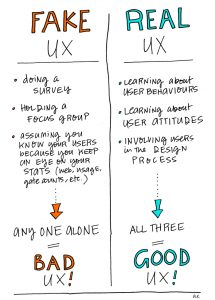You’re standing in front of the photocopier. Everyone else seems to know what they are…

Doing *Real* User Experience Work
In my last column, Brian Herzog shared the hows and whys of his brilliant idea to Work Like a Patron to help library staff build empathy for users. I had a few interesting conversations with folks who read that article (sidebar: I talked to more people about that article than any other article I’ve written for this column! Hooray for Open Shelf and free, open access to content), which went something like this (I’m paraphrasing):
Random librarian: Working like a patron is a great idea. But is that real user experience work?
Me: Hell yes! Anything that gives you insight into the behaviour of your users is real UX work.
Those conversations got me thinking. At the time I found it interesting that most of the librarians I spoke to about that article expressed a sense that there might be a “real” or good way to do UX work, and therefore also a “bad” or fake way to do it. I think those same librarians sort of assumed that there’s a specific, finite set of methods that define UX work and if a particular method (say, Work Like a Patron Day) isn’t part of that set of methods, then that means it’s fake, or bad UX.
Now before we go any further, we need to clear something up: there is no “approved” set of UX methods as such. Indeed, there are basically three types of methods you use when doing UX work (we’ll get into those soon) but the actual methods in those categories are limited only by your imagination (and what you can conceivably do). So the thing that defines real or good UX is not if it uses a recognized, “approved” method, it’s more about your approach to UX work.
So let’s talk more about that approach and those three “types” of methods I mentioned a second ago.
First there’s behavioural research, a type of qualitative research (indeed, most UX methods are qualitative). Behavioural research is the jewel in the user experience crown because UX values user behaviour higher than any other input into the design process. Behavioural research methods do exactly what you expect them to do: they help you learn about your users’ behaviour. They’re invaluable in the early stages of the design process, whether you are designing a new service desk or a new website. Usability testing is probably the most classic example of behavioural research.
Another type of qualitative research, attitudinal research is all about uncovering your users’ attitudes. If you’re thinking, “yeah, we do this”, it’s probably because you do — libraries are good at doing user surveys (a staple in the attitudinal research arsenal) and reaching out to users in other ways to figure out how satisfied they are with our services. Good to remember though that while you can assess the value of a service or resource by doing a survey about it, value alone is severely limited in what it tells you about how your users use that service or resource, and how you might improve it.
The third type of research method is participatory design and it’s sort of like a catch-all category that includes any method that doesn’t fit neatly into one of the two categories above. That could be because the method is part behavioural and part attitudinal. Or it could be that it’s neither. If you’ve ever had a user on a Library committee, someone who is there to represent the end user perspective on something, then you already have a bit of experience with participatory design. Involving your users in your design process to help you make decisions is what participatory design is all about. Another classic example of a participatory design method is the card sort — a testing technique usually used in web design where you have users sort things into categories that make sense to them. While card sorts are usually used when designing web navigation systems, they can be just as useful for real life design problems like signage in your building.
 So back to this business of bad (fake!) and good (real!) UX. As this handy illustration notes, bad UX is pretty easy to do — just put up a survey asking your users what they think! Or get a bunch of users around a table, focus-group-style, and ask them their opinions! Or limit your insights into your users to simply monitoring statistics (whatever those stats may be)!
So back to this business of bad (fake!) and good (real!) UX. As this handy illustration notes, bad UX is pretty easy to do — just put up a survey asking your users what they think! Or get a bunch of users around a table, focus-group-style, and ask them their opinions! Or limit your insights into your users to simply monitoring statistics (whatever those stats may be)!
Turns out, there are all sorts of ways to do UX work poorly, and all those ways are pretty simple to execute, too.
On the other hand, doing UX well is way more difficult. I’d argue that to do really thoughtful and meaningful user experience work, you should be using methods from all three types of research. Call it triangulation. Call it thorough. Or just call it straight up good UX.
Amanda Etches is the Associate Chief Librarian at the University of Guelph Library. You can find more of her writings and doodles at http://e.tches.ca.
